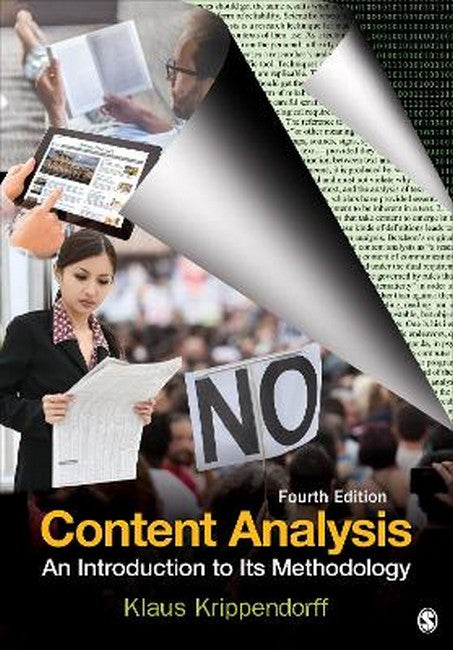Klaus Krippendorff (PhD in Communication, University of Illinois, Urbana, 1967) is Professor of Communication and Gregory Bateson Term Professor for Cybernetics, Language, and Culture at the University of Pennsylvania's Annenberg School for Communication. Besides numerous publications in journals of communication, sociological methodology, cybernetics, and system theory, he authored Information Theory, Structural Models for Qualitative Data, a Dictionary of Cybernetics, edited Communication and Control in Society, and coedited The Analysis of Communication Content and Developments and Scientific Theories and Computer Techniques. Besides supporting various initiatives to develop content analysis techniques and continuing work on reliability measurement, Klaus Krippendorff's current interest is fourfold: With epistemology in mind, he inquires into how language brings forth reality. As a critical scholar, he explores the conditions of entrapment and liberation. As a second-order cybernetician, he plays with recursive constructions of self and others in conversations; and as designer, he attempts to move the meaning and human use of technological artifacts into the center of design considerations, causing a redesign of design - all of them exciting projects.
Request Academic Copy
Please copy the ISBN for submitting review copy form
Description
Preface to the Fourth Edition Introduction PART I. CONCEPTUALIZING CONTENT ANALYSIS Chapter 1. History 1.1 Some Precursors 1.2 Quantitative Newspaper Analysis 1.3 Early Content Analysis 1.4 Propaganda Analysis 1.5 Content Analysis Generalized 1.6 Computer Text Analysis 1.7 Qualitative Approaches Chapter 2. Conceptual Foundation 2.1 Definition 2.2 Epistemological Elaborations 2.3 Examples 2.4 Framework 2.5 Contrasts and Comparisons Chapter 3. Uses and Inferences 3.1 Traditional Overviews 3.2 Extrapolations 3.3 Standards 3.4 Indices and Symptoms 3.5 Linguistic Re-Presentations 3.6 Conversations 3.7 Institutional Processes 3.8 Areas of Likely Success PART II. COMPONENTS OF CONTENT ANALYSIS Chapter 4. The Logic of Content Analysis Designs 4.1 Content Analysis Designs 4.2 Designs Preparatory to Content Analysis 4.3 Designs Going Beyond Content Analysis Chapter 5. Unitizing 5.1 Units 5.2 Types of Units 5.3 Ways of Defining Units 5.4 Productivity, Efficiency, and Reliability Chapter 6. Sampling 6.1 Sampling in Theory 6.2 Sampling Techniques Applicable to Texts 6.3 Sample Size Chapter 7. Recording/Coding 7.1 The Function of Coding and Recording 7.2 Coder Qualifications 7.3 Coder Training 7.4 Crowdcoding 7.5 Approaches to Defining the Semantics of Data 7.6 Records Chapter 8. Data Languages 8.1 The Place of Data Languages in Analytical Efforts 8.2 Definitions 8.3 Variables 8.4 Nominal Variables 8.5 Ordered Variable 8.6 Metrics 8.7 Mathematical Operations Chapter 9. Analytical Constructs 9.1 The Role of Analytical Constructs 9.2 Sources of Certainty 9.3 Types of Constructs 9.4 Sources of Uncertainty PART III. ANALYTICAL PATHS AND EVALUATIVE TECHNIQUES Chapter 10. Analytical/Representational Techniques 10.1 Counts 10.2 Cross-Tabulations, Associations, and Correlations 10.3 Multivariate Techniques 10.4 Factor Analysis and Multidimensional Scaling 10.5 Images, Portrayals, Semantic Nodes, and Profiles 10.6 Contingencies and Contingency Analysis 10.7 Clustering Chapter 11. Computer Aids 11.1 What Computers Do 11.2 How Computers Can Aid Content Analyses 11.3 Text Analyses 11.4 Computational Content Analyses 11.5 Qualitative Data Analysis Support 11.6 Frontiers Chapter 12. Reliability 12.1 Why Reliability? 12.2 Reliability Designs 12.3 Agreement on Coding Predefined Units 12.4 Accuracy, Surrogacy, and the Decisiveness of Majorities 12.5 The Reliability of Text Mining and Information Retrieval 12.6 Agreement on Unitizing and Coding Finite Continua 12.7 Agreement on Multi-Valued Coding 12.8 Statistical Properties of a Chapter 13. Validity 13.1 Validity Defined 13.2 A Typology for Validating Evidence Chapter 14. A Practical Guide 14.1 Designing an Analysis 14.2 Writing a Research Proposal 14.3 Applying the Research Design 14.4 Narrating the Results Glossary References Index About the Author

